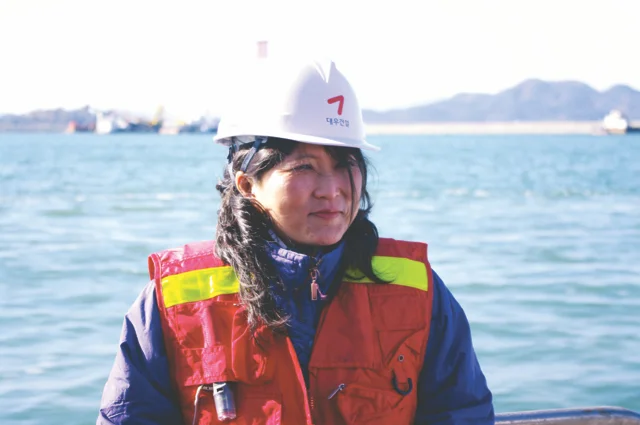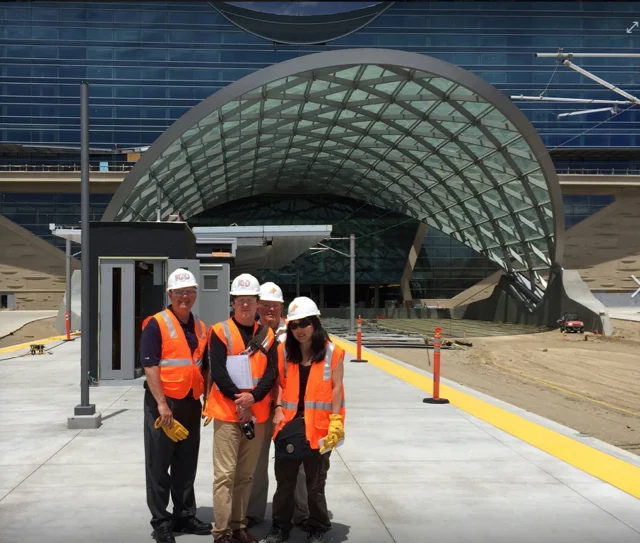A Journalistic Career Propelled by Transportation
A/E/C Stories is an ongoing series of posts featuring individuals who excel in the architecture, engineering and construction industry. Nominate someone.
Serendipity paved the way for Aileen Cho to build an enduring career writing about the world’s most innovative transportation and infrastructure projects.
For more than two decades, she has reported on airports, roads, ports, rail systems, bridges and other infrastructure developments as senior transportation editor at Engineering News-Record.
Cho had no idea what her career path would be when she enrolled at Occidental College, a liberal-arts college in Los Angeles (and the alma mater of former U.S. President Barack Obama). But a journalism course opened her mind to possibilities. “The class was taught by a reporter at the Orange County Register who singled me out as someone who could be a successful journalist,” she says.
The professor urged Cho to apply for a minority editing program at the Los Angeles Times. She earned one of a few coveted slots in the two-year program and began learning the ropes from veteran reporters at one of the nation’s largest daily newspapers.
During the second year of the program, several East-Coast affiliate newspapers traveled to LA to recruit cub reporters for their publications. “I got sent to the Greenwich Time in Connecticut, and that’s where the turning point happened, because the only available beat was transportation and public works,” she says.
Cho began writing about many facets of transportation—from her experience taking a flying lesson to riding with the Coast Guard. And the newly enacted Intermodal Surface Transportation Efficiency Act of 1991 (ISTEA) led to a series of newsworthy infrastructure improvement projects, including several Metro-North track and station upgrades, the repaving of Interstate 95, and a new terminal at Westchester County Airport.
“Suddenly I had all of these news clips that had to do with transportation construction,” she says.
One day, while browsing The New York Times classified ads, she came face-to-face with her destiny. “Lo and behold, there was a job for a transportation editor,” Cho says. “I applied, got an interview and have been at ENR ever since.”
Climbing the Learning Curve
Despite having written extensively about transportation, Cho discovered she still had much to learn.
“One of my first vivid memories was of former ENR Editor-in-Chief Howard Sussman explaining to me the difference between a cable-stayed bridge and a suspension bridge,” she says. “That’s how basic it was for me.”
Early on in her ENR tenure, Cho also discovered one of the most appealing perks of the job: the opportunity to travel around the world and experience awe-inspiring projects.
Her first on-location assignment outside the region was in Aiea, Hawaii, where the Admiral Clarey Bridge (also known as the Ford Island Bridge) was under construction. “It was fascinating to learn about this unique kind of floating pontoon bridge,” she says.
Cho also had her first opportunity to attend the International Bridge Conference, an annual event that attracts more than 1,200 bridge owners and engineers, policy makers, government officials, designers and constructors. “Here I am, this petite Asian girl showing up in a tight-knit crowd of engineers who all seem to know each other,” she says. “The first couple of years, I felt like this weird alien from outer space, wandering around. But as I wrote stories and learned the lingo, the engineers started to appreciate and trust me.”
Women engineers, in particular, went out of their way to encourage Cho. These advocates included Connie Crawford, who served as chief engineer at the New York City Transit Authority; and Ginger Evans, the first female to receive ENR’s Award of Excellence for her role in directing construction of the new Denver International Airport.
“They—and several other women and men—just took me under their wing. They’re a huge reason why I’m still at ENR,” she says.
Through the years, Cho has written about numerous iconic projects: from the historic expansion of the Panama Canal to the construction of an enormous seawall in St. Petersburg, Russia.
Closer to home, she’s covered the World Trade Center transportation hub and several New York City subway projects, including the U.S. Army Corps of Engineers work dewatering the city’s subway tunnels in the aftermath of Hurricane Sandy.
Among the most inspiring projects Cho has written about is the Arthur Ravenel Jr. Bridge over the Cooper River in Charleston, S.C. “It was extraordinary because it’s what every bridge project wants to be: on-time, on-budget and technologically advanced. When I toured it, even the contractors were enthusiastic about it,” she says.
More recently, Cho has traveled to Turkey and Greece to cover various road projects, and she’s currently working on an ENR cover story about the new Champlain Bridge in Montreal.
International travel has reinforced to Cho why she enjoys working with engineers. “They’re just so fact-oriented and fair, and they love building things,” she says. “By and large, they’re just a good breed of people.”
Cho with engineers at the Denver International Airport rail station
Westward Bound
Two years ago, Cho chose to relocate back to the West Coast to be closer to her parents (and a more temperate climate). She now works remotely from Long Beach, California, but stays closely connected to her ENR co-workers via technology.
“I always tell people that if there was a zombie apocalypse, I would want to be with my ENR colleagues in the New York office because they’re the ones I trust,” she says.
In a media landscape characterized by consolidation and turmoil, Cho’s career has been remarkably stable and resilient.
“When I decided to work for a business-to-business publication, a lot of my fellow journalists kind of poo-pooed me, thinking I took the easy way out,” she says. “But I knew I wasn’t cut out for the hardcore, often cutthroat atmosphere of newspapers. I just got lucky that I fell into a situation that not only suited my strengths, but turned out to be more stable than that of mainstream publications.”
With a history that dates back nearly 150 years, ENR is among the most resilient and respected industry publications, with a print circulation of more than 60,000. Since 2015, it has been published by BNP Media.
“Some of my colleagues have been at ENR for more than 30 years,” Cho says. “No one wants to leave.”
Cho visiting the Gerald Desmond Bridge replacement project in Long Beach, Calif.
Previous A/E/C Stories posts:
Why Your Ideal Office May Not Have Four Walls and a Ceiling
Pocketing the Future: This Innovator is Making VR and AR More Accessible
Sound Advice for a Successful Career: Be Yourself
Tales of a Fourth-Generation Construction Manager
An Architect Who Reimagines Classic Buildings and Classic Songs
Attracting the Next Generation of A/E/C Superstars
How to Overcome the Construction Labor Shortage: Hire More Women
An Ambassador and Champion of Design Talent
Embracing the 'Organized Chaos' of Modern PR
A/E/C Podcasting Duo: Why Two Branding Pros Joined Forces
An Entrepreneur Who Helps A/E/C Firms Share Knowledge
Career Shift: From Sports Journalist to Construction Storyteller
Reflections on Three Decades of Architectural Recruiting
Detroit Native Returns Home to Accelerate the City's Revival
Fate Led This Aspiring Architect Toward a Career in Photography
3 Essential Tips for Launching a Successful Communications Career
Discovering the 3D World of Experiential Graphic Design
Top 5 Marketing Dos and Dont's




